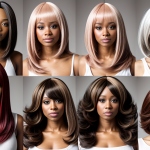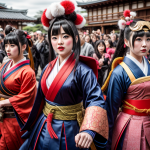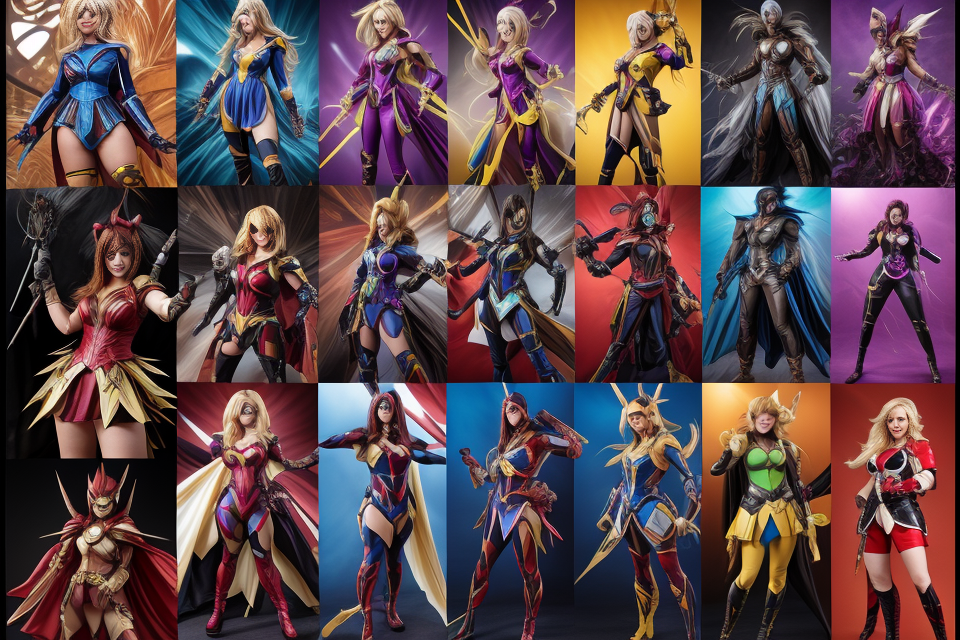Cosplay and costumes are often used interchangeably, but is there really a difference between the two? Cosplay is a type of performance art where participants dress up as characters from movies, TV shows, and video games. On the other hand, costumes are simply clothing worn for a specific occasion or event. While both cosplay and costumes involve dressing up in character, there are distinct differences between the two. In this comprehensive guide, we will explore the differences between cosplay and costumes, and help you understand the nuances of each.
Understanding Cosplay and Costumes
Cosplay Defined
The Origin of Cosplay
Cosplay, short for “costume play,” originated in Japan in the 1980s. It gained popularity through science fiction and anime conventions, where fans would dress up as their favorite characters from manga, anime, and video games. Over time, cosplay expanded beyond the borders of Japan and became a global phenomenon, with cosplayers participating in conventions and events all over the world.
Characteristics of Cosplay
Cosplay is distinguished from regular costume-wearing by its emphasis on transforming oneself into a specific character or fictional being. Cosplayers put significant effort into creating intricate costumes, wigs, makeup, and accessories to fully embody their chosen character. Additionally, cosplay often involves performing the character’s mannerisms, speech patterns, and actions, which sets it apart from simple dress-up.
Popularity of Cosplay
Cosplay has grown in popularity over the years, with more people participating in cosplay events and sharing their creations on social media platforms. The rise of cosplay has been fueled by the growing popularity of science fiction, fantasy, and superhero genres in movies, TV shows, and video games. Cosplayers find joy in expressing their creativity and connecting with other fans who share their passion for these fictional worlds.
As cosplay continues to gain mainstream acceptance, it has also become a source of inspiration for fashion designers and costume makers, who draw on cosplay creativity to create new and innovative designs. The popularity of cosplay has transcended cultural boundaries, with cosplayers from all over the world coming together to celebrate their shared love for pop culture and fictional characters.
Costumes Defined
Costumes are a type of clothing that are worn for a specific purpose or occasion. They are often worn during holidays, parties, or events where a particular theme or dress code is required. Costumes can be made from a variety of materials, including fabric, plastic, and even paper. They can be worn by people of all ages and can range from simple and straightforward designs to elaborate and intricate ones.
Types of Costumes
There are many different types of costumes, each with its own unique style and purpose. Some common types of costumes include:
- Halloween costumes: These are costumes that are worn on Halloween, a holiday that is celebrated on October 31st. Halloween costumes often involve dressing up as a spooky or scary character, such as a ghost, a vampire, or a witch.
- Masquerade costumes: These are costumes that are worn to a masquerade ball or party. Masquerade costumes often involve wearing a mask or other type of disguise to hide the wearer’s identity.
- Theatrical costumes: These are costumes that are worn in a play, musical, or other type of theatrical production. Theatrical costumes are designed to help the wearer portray a character and are often elaborate and detailed.
- Cosplay costumes: These are costumes that are worn by people who are dressing up as a character from a movie, TV show, or comic book. Cosplay costumes are often highly detailed and are designed to replicate the character’s appearance as closely as possible.
Purpose of Costumes
The purpose of costumes is to allow people to express themselves and to fit in with a particular theme or dress code. Costumes can be worn for a variety of occasions, including holidays, parties, and events. They can also be worn for creative or artistic purposes, such as in theatrical productions or cosplay.
In addition to providing a way for people to express themselves, costumes can also be used to add to the atmosphere of an event or to create a sense of fun and excitement. For example, at a Halloween party, costumes can help to create a spooky and festive atmosphere.
Overall, costumes are a fun and creative way for people to express themselves and to participate in various events and activities. Whether you are dressing up for a Halloween party or for a theatrical production, costumes can help you to get into the spirit of the occasion and to have a great time.
Comparing Cosplay and Costumes
Differences in Purpose
When comparing cosplay and costumes, one of the most significant differences lies in their purpose. Cosplay and costumes serve distinct purposes, which are rooted in their respective histories and cultural contexts.
Cosplay as a Form of Expression
Cosplay, short for “costume play,” originated in Japan in the 1980s and has since become a global phenomenon. Cosplayers create and wear costumes based on characters from manga, anime, video games, and other forms of pop culture. Cosplay is more than just dressing up; it is a form of self-expression that allows individuals to showcase their creativity, passion, and fandom.
- Artistic Creativity: Cosplayers often put a great deal of effort into designing and crafting their costumes, using various materials and techniques to achieve an authentic look. The artistic aspect of cosplay is highly valued, and cosplayers often compete in contests to showcase their skills.
- Performance and Role-Playing: Cosplayers not only wear the costumes but also embody the characters they portray. This involves not only the physical appearance but also the mannerisms, speech, and behavior. Cosplayers often engage in role-playing and interacting with other fans, further enhancing the immersive experience.
- Community and Fandom: Cosplay is deeply embedded in the fan culture of various media. Cosplayers attend conventions, meetups, and other events where they can showcase their costumes, meet other fans, and share their passion for the characters and stories they love. Cosplay has become a vital part of fandom, fostering a sense of belonging and connection among like-minded individuals.
Costumes as a Means of Disguise or Representation
Costumes, on the other hand, have a much broader application and are not limited to any specific cultural context or media. Costumes are worn for various reasons, such as for parties, plays, films, Halloween, or even for historical reenactments.
- Disguise and Role-Playing: Costumes often serve as a means of disguise, allowing individuals to take on a different identity or persona. This can be seen in theatrical performances, where actors wear costumes to portray specific characters. It can also be seen in events like Halloween, where people dress up in costumes to create a fun and spooky atmosphere.
- Representation and Cultural Significance: Costumes can also carry cultural and historical significance. For example, traditional cultural dress or historical costumes can represent a particular era or culture. They can be worn to celebrate cultural events or to educate others about the richness and diversity of human history and customs.
- Entertainment and Performance: Costumes are often used in the entertainment industry, such as in films, TV shows, and live performances. They are designed to enhance the visual appeal and immersion of the audience, allowing them to suspend their disbelief and get lost in the story.
In summary, while cosplay and costumes both involve wearing costumes, they differ in their purpose and context. Cosplay is a form of self-expression and creativity, deeply rooted in fan culture and pop media. Costumes, on the other hand, serve a variety of purposes, from disguise and role-playing to representation and entertainment. Understanding these differences can help us appreciate the unique qualities and contributions of each aspect of costume culture.
Differences in Creation
When it comes to the creation of cosplay and costumes, there are several key differences that set them apart. One of the main differences is the level of creativity required for cosplay.
- Level of creativity in cosplay
- Cosplay often requires a high level of creativity as it involves creating a character from scratch. This includes not only designing the costume but also the props, makeup, and hairstyle. Cosplayers must be able to bring their characters to life and capture their personalities through their costumes and performances.
- In contrast, costumes are often based on existing characters or themes, and require less creativity in terms of design. While costumes may still require some level of creativity in terms of materials and construction, they are generally based on pre-existing designs.
Another difference in the creation of cosplay and costumes is the skill and resources required.
- Skill and resources required for costumes
- Costumes are often designed and created by professionals who have experience in sewing, pattern making, and other technical skills. These professionals have access to a wide range of materials and resources, including specialized fabrics, tools, and equipment.
- Cosplay, on the other hand, is often created by amateurs who may not have the same level of technical skill or access to specialized resources. Cosplayers may have to get creative with their materials and construction techniques, and may use a combination of purchased and homemade items to create their costumes.
Overall, while both cosplay and costumes require a certain level of creativity and skill, the type and extent of these requirements can vary greatly depending on the specific project.
Differences in Audience
Cosplay and costumes may seem similar at first glance, but their audiences differ significantly. Cosplay is typically aimed at fans and enthusiasts of a particular genre, while costumes are often worn by the general public for various occasions.
- Fans and enthusiasts in cosplay
- Cosplayers are often passionate fans of a particular genre, such as science fiction, fantasy, or anime. They may attend conventions, meetups, or online communities dedicated to their interests, where they can showcase their cosplay and connect with like-minded individuals. Cosplay is often seen as a form of self-expression and a way to celebrate fandom.
- Cosplayers may spend a significant amount of time and effort creating their costumes, using materials such as fabric, foam, and paint to create intricate details and bring their characters to life. They may also incorporate props, wigs, and accessories to complete their cosplay.
- General public in costumes
- Costumes, on the other hand, are typically worn by people for special occasions or events, such as Halloween, parties, or theater productions. They may be purchased or made by the wearer, and can range from simple and practical to elaborate and ornate.
- The audience for costumes is much broader than that of cosplay, as they are worn by people of all ages and backgrounds. Costumes may be inspired by popular culture, historical events, or personal interests, and can be a fun and creative way to express oneself or fit in with a particular theme.
- While cosplayers may have a deep knowledge and appreciation for the source material of their cosplay, costume wearers may simply be looking for a fun and festive way to dress up for a particular event or occasion.
In summary, the audience for cosplay is typically more niche and passionate, while the audience for costumes is broader and more casual. While there may be some overlap between the two, the differences in audience and purpose highlight the unique qualities and appeal of each.
Intersection of Cosplay and Costumes
Crossover between cosplay and costumes
The world of cosplay and costumes often intersect, with fans and enthusiasts sharing resources and inspiration. Here are some ways in which cosplay and costumes overlap:
Overlapping fans and enthusiasts
One of the most significant ways in which cosplay and costumes intersect is through the fans and enthusiasts who participate in each activity. Many people who enjoy cosplaying also enjoy creating and wearing costumes for other occasions, such as Halloween or comic book conventions. Likewise, those who enjoy creating and wearing costumes may also enjoy cosplaying, either as a hobby or as a way to showcase their costume-making skills.
Sharing of resources and inspiration
Another way in which cosplay and costumes intersect is through the sharing of resources and inspiration. For example, cosplayers may look to costume-making resources and tutorials for guidance on how to create their costumes, while costume-makers may draw inspiration from cosplayers’ creative interpretations of their favorite characters. Additionally, both cosplayers and costume-makers may share resources such as patterns, fabrics, and sewing tools, allowing them to create more intricate and detailed costumes and cosplays.
Collaboration between cosplayers and costume-makers
Finally, cosplayers and costume-makers may collaborate on projects, with cosplayers providing input on the design and fit of the costume, and costume-makers providing expertise on construction and materials. This collaboration can result in stunning and unique costumes that showcase both the cosplayer’s acting skills and the costume-maker’s craftsmanship.
Overall, the intersection of cosplay and costumes is a vibrant and creative space, where fans and enthusiasts can share their passion for character creation and costume-making. By drawing on each other’s strengths and expertise, cosplayers and costume-makers can create truly unique and impressive works of art.
Cosplay as a form of costume
- Using cosplay techniques for costume creation
Cosplay, short for “costume play,” is a subculture that involves dressing up as characters from various media, such as anime, manga, video games, and movies. It is a form of self-expression that allows individuals to showcase their creativity and passion for their favorite characters. Many cosplayers use their skills in sewing, pattern-making, and prop-making to create intricate and detailed costumes. These techniques are also used in creating traditional costumes, but cosplay takes it to a whole new level.
- Examples of cosplay-inspired costumes
There are many examples of cosplay-inspired costumes that have been adapted into traditional costumes. For instance, the classic Batman suit has been adapted into a cosplay costume, but it has also been worn by people attending comic book conventions and Halloween parties. Similarly, the Princess Leia costume from Star Wars has been a popular cosplay choice, but it has also been adapted into a traditional costume for parties and events. These examples show how cosplay has influenced traditional costume-making, and how traditional costumes can be adapted into cosplay.
In summary, cosplay is a form of costume-making that involves creating intricate and detailed costumes based on characters from various media. Many cosplayers use their skills in sewing, pattern-making, and prop-making to create unique and creative costumes. Additionally, cosplay-inspired costumes have been adapted into traditional costumes, showing how cosplay has influenced traditional costume-making.
FAQs
1. What is cosplay?
Cosplay is a hobby or activity where people dress up as characters from movies, TV shows, video games, or other forms of popular culture. Cosplayers often attend conventions or events where they can show off their costumes and interact with other fans.
2. What is a costume?
A costume is a set of clothing or accessories worn to portray a specific character or role. Costumes are often worn for Halloween, theater productions, or other special events.
3. Are cosplay and costumes the same thing?
While cosplay and costumes may seem similar, they are actually quite different. Cosplay is a subculture and hobby that involves creating and wearing costumes to represent characters from popular culture. Costumes, on the other hand, are simply clothing or accessories worn to portray a specific character or role.
4. What is the difference between cosplay and costume play (CP)?
Cosplay and costume play (CP) are similar in that they both involve dressing up as characters from popular culture. However, cosplay is generally considered to be more casual and spontaneous, while CP is more formal and choreographed. CP often involves dressing up as specific characters and performing skits or routines for an audience.
5. Can anyone participate in cosplay?
Yes, cosplay is open to anyone who is interested in dressing up as their favorite characters from popular culture. There are no age or skill requirements, although some cosplayers may have more experience or expertise in creating their own costumes.
6. Do cosplayers have to follow certain rules or guidelines?
Cosplayers are generally expected to follow a code of conduct that promotes respect and inclusivity. This includes avoiding racist, sexist, or other offensive costumes or behavior. Cosplayers should also be mindful of the impact their costumes may have on others, particularly in terms of cultural appropriation or sensitivity.
7. Can cosplay be considered a form of art?
Yes, cosplay can be considered a form of art. Cosplayers often put a lot of time, effort, and creativity into designing and creating their costumes. Some cosplayers even specialize in making their own costumes from scratch, using a variety of materials and techniques. Cosplay can also be appreciated for its photography, performance, and storytelling elements.








